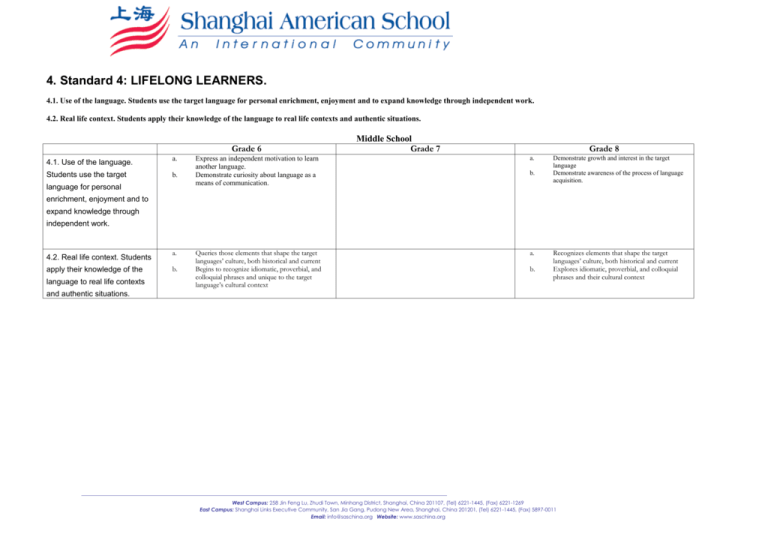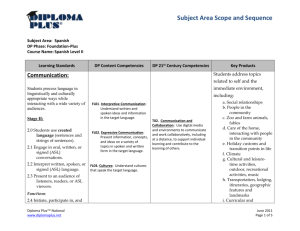4. Standard 4: LIFELONG LEARNERS. - sas
advertisement

4. Standard 4: LIFELONG LEARNERS. 4.1. Use of the language. Students use the target language for personal enrichment, enjoyment and to expand knowledge through independent work. 4.2. Real life context. Students apply their knowledge of the language to real life contexts and authentic situations. Grade 6 4.1. Use of the language. a. Students use the target b. language for personal Middle School Grade 7 Grade 8 Express an independent motivation to learn another language. Demonstrate curiosity about language as a means of communication. a. Queries those elements that shape the target languages’ culture, both historical and current Begins to recognize idiomatic, proverbial, and colloquial phrases and unique to the target language’s cultural context a. b. Demonstrate growth and interest in the target language Demonstrate awareness of the process of language acquisition. enrichment, enjoyment and to expand knowledge through independent work. 4.2. Real life context. Students apply their knowledge of the language to real life contexts a. b. b. Recognizes elements that shape the target languages’ culture, both historical and current Explores idiomatic, proverbial, and colloquial phrases and their cultural context and authentic situations. West Campus: 258 Jin Feng Lu, Zhudi Town, Minhang District, Shanghai, China 201107, (Tel) 6221-1445, (Fax) 6221-1269 East Campus: Shanghai Links Executive Community, San Jia Gang, Pudong New Area, Shanghai, China 201201, (Tel) 6221-1445, (Fax) 5897-0011 Email: info@saschina.org Website: www.saschina.org SAS High School Level I Level II HS Level III HS Level IV a. Formulates justification for continued growth and interest in the target language/culture b. Generates opportunities for further study of additional languages and cultures based on perspectives from target language 4.1. Use of the language. Students use the target language for personal enrichment, enjoyment and to HS Level V (exception) a. Demonstrates complex thinking in and sensitivity to target languages’ culture (e.g., nuances demonstrating analysis, interpretation, and value judgments) Initiates conversations or activities regarding impact of diverse cultures (current or historical events on the target languages’’ culture b. expand knowledge through independent work. . 4.2. Real life context. Students apply their knowledge of the language to real life contexts and authentic situations 4.1. Use of the language. a. Begins to recognize idiomatic expressions b. Queries those elements that shape the target languages’ culture, both historical and current c. Interacts using culturally appropriate language to authentic situations (e.g., greetings, ordering in a restaurant/cafe, buying items, giving basic directions) a. Recognizes and uses some idiomatic expressions b. Recognizes elements that shape the target languages’ culture, both historical and current c. Interacts for a sustained period using culturally appropriate language to authentic situations (e.g., asking for and giving directions, interacting in a professional setting, explaining problems with merchandise) ab initio 1 (Level I) a. Demonstrate consideration of ab initio 2 Students use the target language for personal enrichment, enjoyment and to expand knowledge through independent work. b. a. Identifies elements that shape cultural identity in the target language’s cultures and variances by region, with own (e.g., colonization, geography, climate, education, political climate, the arts, economy) b. Discerns connections between idiomatic, proverbial, and colloquial expressions in the target language & culture as they contrast with interactions from other cultures c. Interacts for a sustained period using culturally appropriate language to authentic situations (e.g., exchanging information, visiting the doctor, expressing opinions, making suggestions, hypothesizing in the past) External Exam – High School IB B SL/HL Year 1 and sensitivity to target languages’ culture (e.g., lists facts, gives information, provides basic narration) Responds to questions regarding current or historical events relating to the target languages’ culture a. Compares, in the target language, elements that shape cultural identity in the target language’s cultures and variances by region, with own (e.g., colonization, geography, climate, education, political climate, the arts, economy) b. Analyzes the use of idiomatic, proverbial, and colloquial expressions in the target language based on interactions with individuals from other cultures. a. b. IB B SL/HL Year 2 c. Demonstrates complex thinking in and a. Compares, in the target language, elements that shape cultural identity in the target language’s cultures and variances by region, with own (e.g., colonization, geography, climate, education, political climate, the arts, economy) Analyzes the use of idiomatic, proverbial, and colloquial expressions in the target language based on interactions with individuals from other cultures. AP sensitivity to target languages’ culture (e.g., nuances demonstrating analysis, interpretation, and value judgments) Initiates conversations or activities regarding impact of diverse cultures (current or historical events on the target languages’’ culture . 4.2. Real life context. a. Begins to recognize idiomatic expressions a. Recognizes and uses some idiomatic expressions a. Compares, in the target language, elements that shape cultural a. Compares, in the target language, elements that shape cultural identity a. Compares, in the target language, elements that shape Students apply their knowledge of the language to real life contexts and authentic situations b. Queries those elements that shape the target languages’ culture, both historical and current c. Interacts using culturally appropriate language to authentic situations (e.g., greetings, ordering in a restaurant/cafe, buying items, giving basic directions) b. Recognizes elements that shape the target languages’ culture, both historical and current c. Interacts for a sustained period using culturally appropriate language to authentic situations (e.g., asking for and giving directions, interacting in a professional setting, explaining problems with merchandise) identity in the target language’s cultures and variances by region, with own (e.g., colonization, geography, climate, education, political climate, the arts, economy) b. Analyzes the use of idiomatic, proverbial, and colloquial expressions in the target language based on interactions with individuals from other cultures. in the target language’s cultures and variances by region, with own (e.g., colonization, geography, climate, education, political climate, the arts, economy) b. Analyzes the use of idiomatic, proverbial, and colloquial expressions in the target language based on interactions with individuals from other cultures. cultural identity in the target language’s cultures and variances by region, with own (e.g., colonization, geography, climate, education, political climate, the arts, economy) b. Analyzes the use of idiomatic, proverbial, and colloquial expressions in the target language based on interactions with individuals from other cultures.







